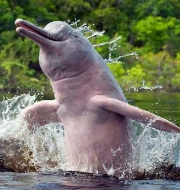Gangetic River dolphin declared city animal of Guwahati
Assam’s Guwahati became the first city in the country to have its own city animal after Kamrup metropolitan district administration declared Gangetic River dolphin as its official mascot.
Gangetic River Dolphin locally in Guwahati is known as ‘Sihu’ and it is on the verge of extinction. Less than 2,000 Gangetic river dolphins remain in the Brahmaputra River along Guwahati.
Background
- The Kamrup metropolitan district administration had organized the three-month long online and off-line voting process among three protected animals to decide the ‘city animal’.
- The voting process was conducted by district administration along with other organisations such as Assam forest department, Assam state biodiversity bard and Help Earth (NGO).
- These three animals were Gangetic River Dolphin (local name: Sihu), Greater Adjutant Stork (Hargila) and Black Softshell Turtle (Bor Kaso). These three animals are on the verge of extinction.
- In this voting process Gangetic River dolphin had received highest 24247 votes out of 60003 total votes. While, Greater Adjutant Stork got 18454 votes and Black Softshell Turtle got 17302 votes.
Note: Ganges River dolphin has been official declared as National Aquatic Animal of India.
About Gangetic River Dolpin
- The Gangetic Dolpin are also called as the ‘Tigers of Ganga’ as it enjoys the position in Ganga that is equivalent to that of the tiger in the forest.
- Scientific name: Platanista gangetica.
- Habitat: Being freshwater dolphin they prefer deep waters in and around the confluence of two or more rivers. They share their habitat with fresh water turtles, crocodiles and wetland birds.
- Characteristic features: It has a sturdy, yet flexible body with large flippers. It has a low triangular dorsal fin. It weighs up to 150 kg. Males are smaller than females. Gangetic Dolpins are generally blind and use ultrasonic sound to catch their prey.
- Protection status: IUCN has listed it as ‘endangered‘. It is also placed in Schedule-I of the Wildlife (Protection) Act, 1972.
- Threats: Entanglement in fishing nets, hunting for their oil and meat, poisoning of water supply of river from industrial and agricultural chemicals.
- They are facing most significant threat from building of dams along the upper course of their habitable rivers. It causing the segregation of populations and has a narrowed gene pool in which dolphins can breed.
- Conservation Programme: Union Government (MoEFCC) had launched Ganges River Dolphin Conservation Programme in 1997 to build a scientific database of their population status and also study their habitat quality of the dolphins’ distribution range.
Month: Current Affairs - June, 2016








sai
June 14, 2016 at 1:12 pmGood selection for City Guwahathi.
it helps the people who are in danger.
keep it up.
Thanks
sai
June 14, 2016 at 1:12 pmGood selection for City Guwahathi.
it helps the people who are in danger.
keep it up.
Thanks